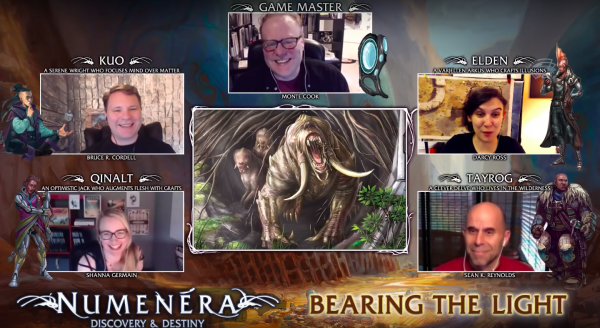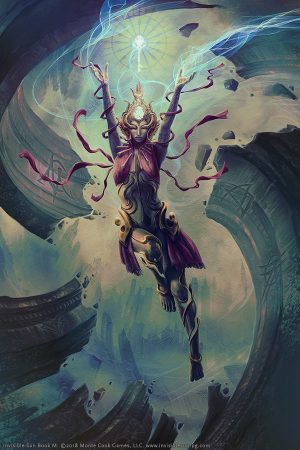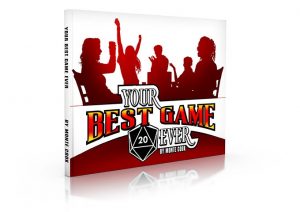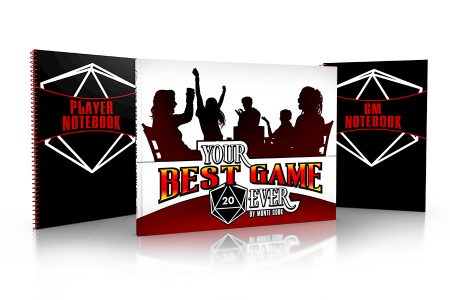Like most advice, gaming advice is contextual. The techniques for creating wonderful gaming experiences vary based on whether you’re a GM or a player, whether you’re playing with old friends or total strangers, and where you’re playing. Are you at a game store, a friend’s house—or online?
In Your Best Game Ever, you’ll find an entire chapter on playing games online. We’ve excerpted that chapter here, so read on to discover our top tips for overcoming the invisible barrier of online gaming.
Overcoming the Invisible Barrier
While the technology’s not too challenging, running and playing the game can be. If you’re used to sitting in the same room with your friends, you’ll find what I’m going to call the invisible barrier between you all. You’re not in the same physical space, so a distraction for one person (a TV on in the next room, for example) isn’t a distraction for everyone else. Player attention wanders in a way that it might not if you were in the same locale—you’re all (by definition) sitting in front of a computer, so you check email. Or social media. The technology gives the illusion of proximity, but there’s still a psychological distance between everyone. The issue comes down to communication and engagement.
The invisible barrier’s not insurmountable. You just need a few guidelines to help get around it.

Remain Aware
The first step to overcoming the invisible barrier is recognizing that it’s there and that it affects players differently. The person in the later time zone sitting in the dark starts to get sleepy. The person who’s more prone to distraction has greater opportunity to let their mind wander. Players who otherwise would be attentive if they were sitting among their friends find that they can’t sit alone in a room doing nothing while someone else takes a turn, so they start checking Instagram or playing a game on their phone.
You have to remain aware of the barrier. If you forget and lapse into the same mindset you’d have at the table, you might to start to see problems arise and some of the players start to drift away.
Keep up your energy, and don’t let any one player drift off. Keep everyone engaged. If someone’s quiet, address them specifically and ask what they think, what they plan to do, or something of that nature. Anything to bring them back to the game. And keep in mind that this isn’t just the GM’s problem to solve. Everyone involved should work toward this goal and remain aware of the problems that can arise and the distance that can form between each other.
Focus on Visuals

The second suggestion is to use visuals to stimulate interest and engagement. Many apps allow for screen sharing or have a way to show an image or a map to help immerse everyone in the game. In some ways, this is an advantage to online gaming, particularly if you’re using an app that can show everyone the same map, indicate character positions on that map, and so on. And visuals aren’t just the GM’s responsibility. Players can find artwork that represents their character, their favorite item, or the little town where they’re from.
Ironically, online gaming might be the time to break out physical props—specifically, those that can be held up to the webcam for everyone to see. Artwork, maps, notes, handheld items . . . if it’s something you can hold up to the camera, it will be just as effective in this medium, if not more.
Last, you can use props online to great effect that you’d never bother with in an in-person game. Say an NPC just inflicted 7 points of damage on one of the PCs. The GM can hold up a playing card with a 7 on it. The player can then hold up their own card with a 7. Or maybe they hold up a 3, because that’s how many hit points they have left. This works for initiative and other mechanics as well.
Increase Player Agency
Another way to deal with the invisible barrier is to turn up the volume on player agency. It’s everyone’s responsibility to keep up the energy level in a game, to help contribute to the story, and to make things interesting for everyone else. In an online game, players should take even more upon themselves. One way to do that is for the group to agree that the players have more agency over the narrative and the world. Everyone will pay extra attention—despite the barrier—if they can make suggestions about what’s going on around them. To facilitate this, the GM can call on the players for contributions even—or perhaps particularly—when it’s not their turn. “Keith, what does the guard say when Sarah’s character approaches?” “Richard, what are the bystanders in the back doing?” This increases engagement. (This kind of thing isn’t everyone’s play style, but it might be fun to try. Regardless of your preference, the whole group should be comfortable with understanding where player agency over the narrative and the setting begins and ends.)
Your Best Game Ever
In addition to the book Your Best Game Ever, we’ve created special accompanying GM Notebooks and Player Notebooks! Both notebooks are system-agnostic, spiral bound, beautiful, and amazingly useful at the game table and between sessions.

